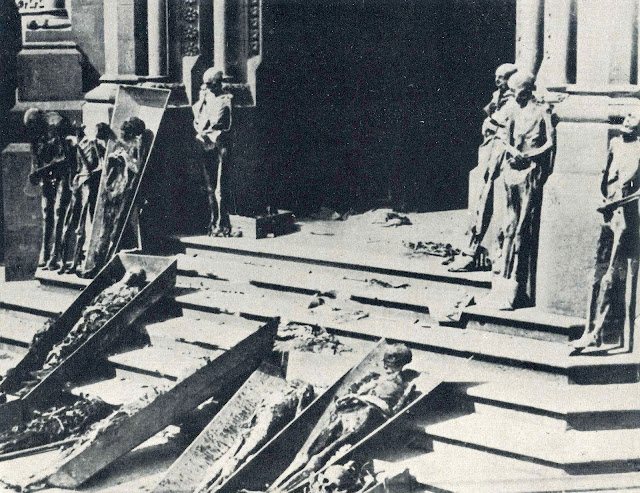Civilian German citizens worked to remove bodies and bombs from the rubble from the ruins of Hamburg, which had collapsed in an indiscriminate British air raid. The corpses of civilian German citizens who were killed in the bombing by plunging headfirst into the rubble were buried in the scattered rubble. Civilian German citizens searched for their relatives and bodies in the rubble.
In the eleven days of the summer of 1943 alone, Allied bombers carried out six massive, indiscriminate raids on some 1.75 million civilians in Hamburg, Germany's second largest city. In addition to attacking German munitions factories, they also targeted German workers and their families in all cities with a population of over 100,000 to demoralize the war effort. The Royal Air Force (RAF) went crazy with civilian Germans as part of the German war machine. The only defense was offense, killing more enemy women and children faster to save their country. German citizens in the city of Hamburg called it a deadly catastrophe (die Katastrophe). A notorious, dangerous and indiscriminate air raid bombed Hamburg, collapsing some 280,000,000 buildings. Buildings were pulverized, set on fire, roads were blocked, water pipes burst, and windows and roofs were blown off. Hot winds reached a maximum of about 240 km/h, temperatures reached about 800 degrees Celsius, and residents were sucked into the flames. About 17,000 bombers bombed the city with more than 90,000 tons of bombs. About 34,000 to 43,000 German civilians, half the number of victims of the Nagasaki bomb, were killed.
Starting on July 24, 1943, British bombers launched a midnight raid on Hamburg, Germany in Operation Gomorrah. Some 167 British civilians had been killed in the Luftwaffe's July bombing raids alone, and beginning in the evening of July 24, some 791 British bombers dropped some 2,300 tons of incendiary bombs on Hamburg in just a few hours. More than about 1,500 German civilians were killed in the first British air raid. Meanwhile, the U.S. Air Force (USAAF) launched two raids on Hamburg during the day and then bombed extensively from northern Germany during Blitz Week. It continued its strategy of wiping out Berlin, Dresden, and dozens of other cities until the end of World War II.

























